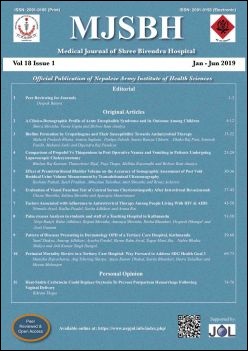A Clinico-Demographic Profile of Acute Encephalitis Syndrome and its Outcome Among Children
Keywords:
Acute encephalitis syndrome (AES), Bacterial meningitisAbstract
Introduction: Acute Encephalitis Syndrome (AES) is defined as acute onset of fever and a change in mental status and/or new onset of seizures in a person of any age, in any geographical region, at any time of year. It may be due to viral or bacterial etiology. Dysfunction of motor system and mental retardation are common complications.
Methods: A prospective cross-sectional hospital based study was done among children from 1 month to 15 years of age admitted with diagnosis of AES from October 2014 to October 2015. The clinical details and reports of CSF analysis were recorded and analyzed.
Results: Out of 70 patients of AES admitted, 40 (57.10%) were male and 30 (42.90%) were female. The highest number of cases were in age group of 6-10 years i.e. 26(37.2%); whereas 20 (28.5%) were 11-15 years, 17(24.30%) were among 2-5 years and 7(10%) were below 2 years. The patients were predominantly from Far- Western and Mid-Western region of Nepal. The maximum AES cases were of farmers of lower education level from rural area with low socio economic group and were reported during monsoon. The clinical profiles of AES were fever, altered sensorium and convulsion followed by irritability, headache, vomiting, lethargy, photophobia and ear discharge. 50 patients had AES with viral origin including nine were Japanese Encephalitis and 41 were Viral with unknown etiology whereas 20 were of Bacterial origin which includes 15 were Bacterial (septic) meningitis and five of Tubercular meningitis. Three children (4.3%) died with diagnosis of viral encephalitis. 29 (41.4%) had complete recovery and 15 (21.4%) had partial recovery, nine (12.9%) went LAMA (left against medical advice) and 14 (20%) were DOPR (discharge on patient request). The partially recovered patients had sequelae of motor system dysfunction and mental retardation.
Conclusion: Acute encephalitis syndrome is a medical emergency in which early detection and treatment is very essential and remains a serious threat to global health, especially in the developing countries.
Downloads
Downloads
Published
How to Cite
Issue
Section
License
This license enables reusers to distribute, remix, adapt, and build upon the material in any medium or format for noncommercial purposes only, and only so long as attribution is given to the creator.




